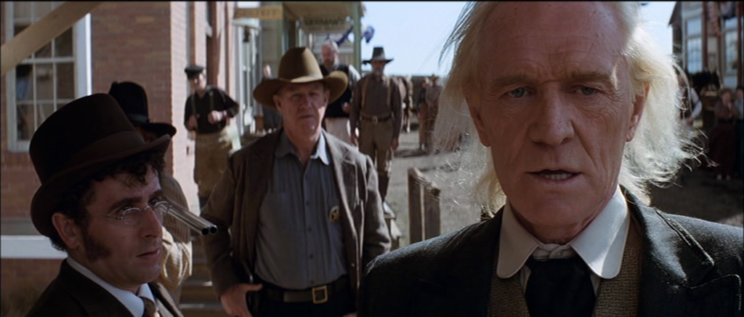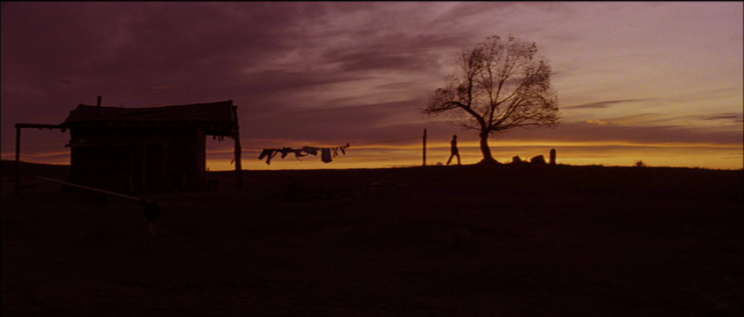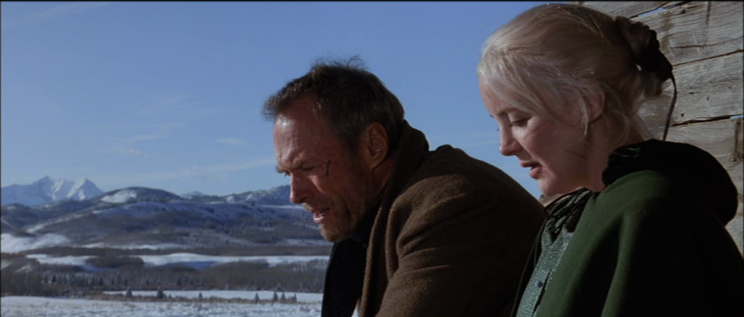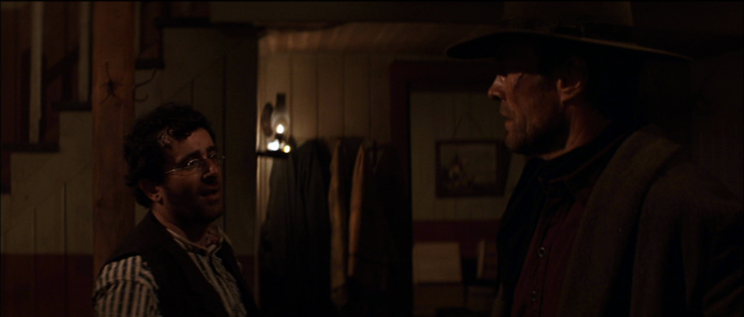…in which 25 years into my familiarity with one of the greatest Hollywood movies ever made, I realize something that either counts as a fan theory or proves I’m a massive idiot for not noticing what now seems so bloody obvious.
(NOTE: This post has been EDITED to correct errors since it was posted)
(ANOTHER NOTE: Since this was posted, I have learned that someone was actually able to ask David Webb Peoples in person about this theory of mine. I am told he got a “funny look” on his face, then said that this hadn’t been on his mind in the writing of the script, but that he wished he had thought of it.)
Clint Eastwood is still making movies, but he has still not gone back on his word that he was done with the Western. In many ways, he not only finished the genre for himself, he put a punctuation mark on it that was about as decisive as a bullet going into an old horse. While revolvers and wide-brimmed hats can still successfully pop some corn once a year or so, it always feels once removed from its pure state. We now get the descendants of the genre – comedies, subversions, revisions, or just an echo in the art of film itself that can resonate off modern-set tales like No Country for Old Men and Hell or High Water.
Unforgiven used everything that was pure and great about the classic Western, while simultaneously chasing the genre to the blackest and most uncomfortable truths within. Like Heart of Darkness, it’s a journey, and a tale-within-a-tale, and no one who touches its narrative leaves unscathed.
It knows that myth-making wasn’t some post-facto response to the Western expansion; it was as present on the rapidly-civilizing frontier as dime novels and Wanted posters, where the story of a person could outrace a locomotive.
Reputation, reputation, reputation! Oh, I have lost my reputation! I have lost the immortal part of myself, and what remains is bestial. My reputation, Iago, my reputation!
That quote is from Cassio in Shakespeare’s Othello, and it touches on the brutal truth that men who cling to their own false self-image are ripe to get into trouble. The whole plot of Unforgiven is set in motion by the cowboy “Big” Mike’s embarrassment when a prostitute named Delilah (Anna Levine, credited as Anna Thomson) giggles at the size of his member – a brief and most personal example of a boastful “reputation” colliding with a (literally) measurable reality. “Big” Mike mutilates her in a rage. It is a running theme of the movie; where mens’ lies about themselves receive pitiless, brutal answers.

One of the film’s ingenious devices for activating this theme is a supporting character played by the great Saul Rubinek – a pulp writer named W.W. Beauchamp. When we meet him, he’s traveling in the company of English Bob (Richard Harris), a vainglorious gunman in fancy duds headed for the town of Big Whiskey, chasing the rumors of the “Whores’ Gold” bounty on the heads of the cowboys who cut and scarred Delilah. Beauchamp soaks up all of English Bob’s pompous exaggerations and pontifications, and turns them into over-soaked prose under the name The Duke of Death. When Bob is subsequently beaten near to death by Sheriff “Little” Bill Daggett (Gene Hackman) and run out of town, Beauchamp sticks around, now an eager party to Daggett’s perspective on the “real” West as a cynical game of dominance with himself as the savvy, house-building hero.
I call characters like Beauchamp “Socratic screens”, because they allow deluded other characters (which, really, most of the most interesting characters are deluded about themselves in some way) to project themselves onto someone; leading to them unwittingly revealing what they hoped to keep hidden. In multiple scenes, Beauchamp is just there, off to the side, taking notes, encouraging the bloviation; I can tell you first hand, if you tell a certain type of personality that you’re a writer, they will lavish you with their self-image. Which is catnip for Beauchamp, until, when Daggett has captured Ned Logan (Morgan Freeman) and is torturing him for information, Beauchamp’s note-taking is enlisted to a corrupted purpose. Daggett makes him complicit in the violence by using his transcriptions to trip up Ned’s lies about himself and William Munny; and Beauchamp is so excited to be witnessing a thrilling Western story in real-time that he does not see the soul-darkening extent to which he has been seduced.
And then Munny arrives, and all accounts are called in.

William Munny himself is introduced to us as a legend; and it seems everywhere he goes, his reputation precedes him. He’s likely been credited with more murders than he ever actually committed; it’s also likely he was too drunk to know the true count, and is prepared to wear the guilt of all the made-up deaths, too. The Schofield Kid – who has both awarded himself his own nickname and fluffed his own accounting of his deeds – seeks out Munny for his reputation in the hopes of splitting the bounty of Big Whiskey with him. Little Bill, staring down Munny from the wrong end of a shotgun, uses Munny’s reputation in a failed tactic to rattle the man.
But his legend has become two-fold – one part is about the violence. The other part is about his life beyond it.
When I cite Unforgiven in my screenwriting class, there’s a lot of writing gold to use, but one of the most enduring pieces of genius in David Webb Peoples’ script is the brief narrative title cards used to bookend the story.
Over the opening wide shot of Munny’s farm, and a silhouette digging a grave, we see the following text:
She was a comely young woman and not without prospects. Therefore it was heartbreaking to her mother that she would enter into marriage with William Munny, a known thief and murderer, a man of notoriously vicious and intemperate disposition.
When she died, it was not at his hands as her mother might have expected, but of smallpox. That was 1878.
That poetically-sparse text packs in a whole lot of story. A character we never meet in the flesh – Munny’s late wife – is rendered and made an active part of the narrative. When Munny takes about her to Delilah, he does not mention her death; from his perspective, his promise to strive to leave his dark ways behind him is alive and intact, and thus, so is her memory and her influence on him.
And after he commits his vengeful massacre at Big Whiskey and returns to his failing hog farm, there is another block of text.
Some years later, Mrs. Ansonia Feathers made the arduous journey to Hodgeman County to visit the last resting place of her only daughter.
William Munny had long since disappeared with the children…some said to San Francisco where it was rumored he prospered in dry goods.
And there was nothing on the marker to explain to Mrs. Feathers why her only daughter had married a known thief and murderer, a man of notoriously vicious and intemperate disposition.
Still another character, the judgmental yet grieving Mrs. Feathers, is created for us in just a few letters, and we in the audience are left with her uncertainty, which will never be satisfied.
When I talk about this in screenwriting class, I describe how the text sets up an emotional mystery – how could a woman fall in love with William Munny? – which runs quietly under all the action. Mrs. Feathers never gets her answer. But we in the audience do – we watch it happen right in front of us.

Delilah, who starts as a powerless recreational object for men and then even has that taken away from her when her face is scarred, tends to Munny as he recovers from a beating by Little Bill. He’s neither overly affectionate to her nor totally indifferent; but there is a simple respect and courtesy in how he addresses her that is miles away from the behavior of anyone in Big Whiskey. When he turns down her offer of a “free one”, he can see how traumatized she still is by the assault on her, and how she has interpreted his rejection as a rejection of her appearance. He delicately salvages her ego.
And when he rides out of town, threatening to kill anyone he sees, the one person who does emerge to watch him ride into the darkness is her. For us, we do not wonder how a woman could have fallen in love with William Munny – because the person who saw not just his horrible reputation but his desperate striving to be something else on Earth even if he is doomed to Hell after, did fall in love. It’s the Western view on the essential paradoxes contained in existence and morality, rendered in impeccable drama, and carried by the arc of a female character in a world where men violently hoard all the agency.
That makes the narrative text a brilliant means of enriching the emotional texture of the movie, while reinforcing its theme and conducting the audience’s journey into and out of the story. It does so much, and there is so much else which is captivating about the movie, that you could possibly, as I have done since the movie came out until just a couple of days ago, overlook a provocative question buried in that text.
Who wrote that story?
It’s pretty easy to say “the screenwriter”, and that’s an apt and true answer; but it’s written in the very heightened style of the movie’s dialogue. It feels as though it belongs within the world of the movie, that it might have ended up in a book on a shelf somewhere to be read and discovered by someone burning to know more about the West and the characters who inhabited it.
And then it hit me like a rifle shot – the answer is already there in the movie:

Not many survive the shootout at Skinny’s. But W.W. Beauchamp, still present, just off to the side, is unscathed. In shock, yes, but ever the curious writer. He wants answers – how did Munny know who to shoot first? Munny has no answers, he’s always been lucky when it comes to killing. Beauchamp only shuts up when Munny threatens to kill him too, and more than at any point in the narrative, you can tell Beauchamp knows that lethal, real danger has found him. But he still wants to know.
What happens to a man like that after an experience like that? I’ll tell you what I believe is plausible. I think it’s plausible that W.W. Beauchamp, shocked out of his own pulp pretensions of his capabilities, haunted by the way he was conscripted into Ned Logan’s death, saw in William Munny a hope to find truth, and started chasing every legend he could find about the man. Because maybe if he could tell that story, he might find his own forgiveness. Only an obsessed writer could journey to the farm, could thread together the rumors about the dry goods store, or locate Mrs. Feathers and find her opinion on the matter. That brief text turns out to hint at yet another story – the story of a storyteller humbled and seasoned by his experiences, knowing he could never answer the contradictions of William Munny, but that he might be able to put them in a frame for an audience who wanted to hear about them. I’d even venture that, judging by the brief example we get, his writing has improved since his days with English Bob.
I’d read a story about that person. I’d watch that movie. Some great films seem to have great stories branching out from them in all directions. And maybe my theory is as bunk as The Duck of Death. But I can tell you that I am enough under the spell of Unforgiven still to believe this 25-year old movie has secrets like this left to tell.
Amazing theory…..Absolutely brilliant!